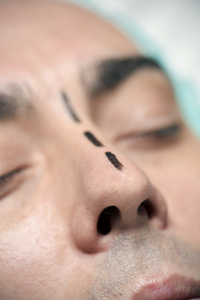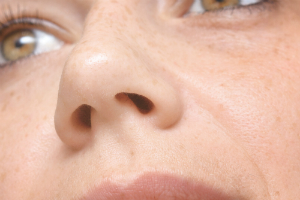When you hear the word “rhinoplasty” your first thought might have to do with the cosmetic appearance of the nose. While it’s true that many patients will seek rhinoplasty to improve their facial harmony, there are other benefits to the procedure as well.
The functionality of the nose is equally important to its aesthetic form. Many patients suffer from breathing abnormalities that are related to the structure of their noses, although unbeknownst to them.
Breathing trouble will typically occur during exercise or sleep. You may snore loudly, to the dismay of your spouse, or find that you tire easily while exerting yourself physically. What may seem like an inconvenience or lack of fitness may very well have to do with the structure of your nose.
During rhinoplasty consultations at The Whole Beauty® Institute Dr. John Q. Cook carefully examines each patient in order to determine whether there are functional aspects of the nose that can be corrected.
Correcting a Deviated Septum

The rhinoplasty operation can include a septoplasty, which straightens the septum and removes any portion of the septum that interferes with air flow. This opens up the internal breathing passages and restores normal breathing.
It’s not unusual for septoplasty, or any other rhinoplasty performed for medical reasons, to improve the appearance of the nose. A deviated septum will often make the nose appear bent or crooked. Straightening the septum will restore a straight appearance to the nose when viewed from the front. This can supplement the benefits of other steps of the rhinoplasty operation that help improve appearance.
Fixing the Nasal Valves
Most people are aware that a deviated septum can make it difficult to breathe. Even many doctors do not understand that abnormalities of the nasal valves can have an equally powerful effect on breathing.

During the rhinoplasty consultation, Dr. Cook performs several tests that will reveal whether or not there is a problem with the nasal valves. He can then simulate the effect of surgery to improve valve function. It can be a dramatic experience when a patient finds out what normal breathing is like.
When Dr. Cook performs surgery to improve the function of the nasal valves, he obtains grafts of cartilage from the nasal septum and places them in a position to strengthen the support of the valves. This often improves the aesthetic appeal of the nose as well, since noses with weak valves often have a pinched appearance.
Providing Minor Allergy Relief
Another added benefit of rhinoplasty is the reduction of allergy symptoms in some patients. Although rhinoplasty will not cure allergies (as the condition is brought on by environmental sources and the patient’s immune response) it may provide some relief for those who also have functional problems with their noses.
The body’s immune response to allergens generally leads to a swelling of the nose’s internal lining and the production of excess fluid that runs out through the nostrils. When combined with a structural abnormality like a deviated septum, air flow can become compromised and fluid can back up. By correcting the septum, air flows through the nose with less obstruction, reducing congestion and making over-the-counter medications more effective. For some people who suffer from chronic allergies, corrective rhinoplasty can reduce their discomfort.
Is Rhinoplasty Right for You?
As with any procedure, whether it’s for form or function, consulting with Dr. Cook will help you determine whether you would benefit from rhinoplasty. By examining the structure of your nasal cavity and observing the contours of your face, he can design a treatment plan for a rhinoplasty that addresses your breathing concerns and aesthetic goals.
For more information or to find out whether rhinoplasty is right for you, contact The Whole Beauty® Institute at 312-751-2112 and schedule a consultation.


